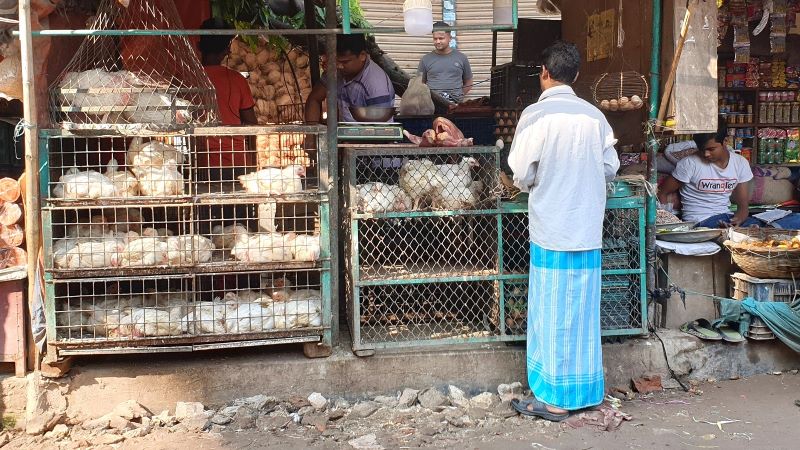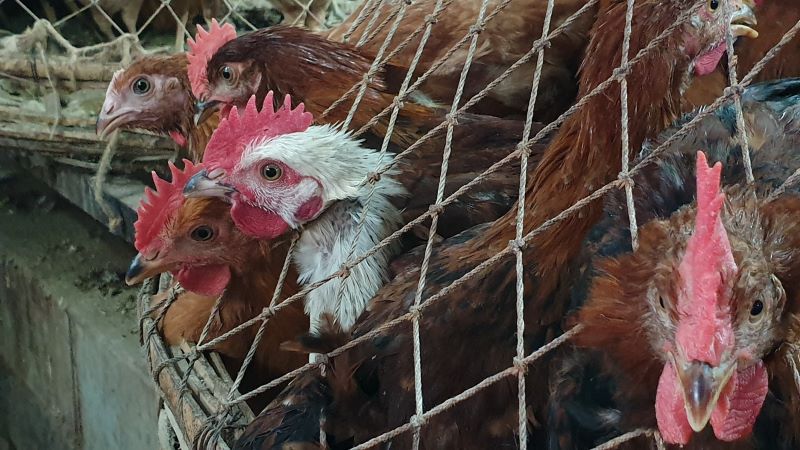New research from the RVC and the One Health Poultry Hub reveals speed of avian flu transmission
New research from the Global Challenges Research Fund’s (GCRF) One Health Poultry Hub, including researchers from the Royal Veterinary College (RVC) has, for the first time, modelled the transmission of avian influenza (‘bird flu’), revealing the speed at which it can spread in Asia’s live bird markets. The findings will help researchers evaluate the impact of potential control measures to reduce H9N2 (a subtype of avian influenza) in markets.

H9N2 is a zoonotic virus that is defined as low pathogenic and causes mild diseases that can lead to production losses for chicken farmers. Genes from H9N2 have however, also been found in the emergence of new influenza virus variants, making it a potential pandemic threat with its first human infection reported in Vietnam in April 2024.
Published in Nature Communications, researchers from the RVC; University of Oxford; City University of Hong Kong, China; Chattogram Veterinary and Animal Sciences University, Bangladesh; and the French National Research Institute for Agriculture, Food and the Environment, used biological data obtained from chickens in live bird markets and a computer modelling system to determine the transmission rate.
While previous attempts to model avian influenza have been theoretical, this study found that:
- More than nine in 10 chickens that enter live bird markets without having been previously exposed to the H9N2 subtype of avian influenza virus become infected with it, should they remain there for one day.
- The time between a bird being infected with H9N2 and it becoming contagious can be less than five and a half hours in a live bird market.
- One in 10 birds arrive at live bird markets already exposed to H9N2.
These findings follow additional new research from the GCRF One Health Poultry Hub, which has found that two to three in 10 chickens in live bird markets in Bangladesh and Vietnam, test positive for H9N2.
Currently, veterinary public health interventions to limit and prevent the spread of the virus focus on addressing the disease in the markets, including banning the storage of birds overnight, enforcing market ‘rest days’ and separating bird species in the markets. The findings from this research however, can now be used to inform the first-of-its-kind EPIdemic Network Simulation in Poultry Transportation Systems (EPINEST) computer model to map and track avian influenza virus spread across time and space.

Dr Guillaume Fournié, Researcher at the RVC and INRAE, said:
“Our research suggests that unless any practical measures designed to protect market traders and shoppers are complemented by interventions in the networks and supply chains that deliver the birds to market – they are unlikely to have enough impact. To be successful a pandemic prevention strategy must also target chicken farmers and transporters in countries where the virus is endemic in order to reduce viral burden in markets.
“Our findings make a clear case for considering multipronged interventions, including vaccination strategies for all poultry destined for sale in live bird markets.”
The GCRF One Health Poultry Hub is funded by UK Research and Innovation through the GCRF. It is part of the UK’s Official Development Assistance, which is managed by the Department for Science, Innovation and Technology.
Notes to Editors
Reference: Pinotti F, Kohnle L, Lourenço J, Gupta S, Hoque MA, Mahmud R, Biswas P, Pfeiffer DU, Fournié G (2024) Modelling the transmission dynamics of H9N2 avian influenza viruses in a live bird market. Nature Communications.
The full paper can be accessed at: https://www.nature.com/articles/s41467-024-47703-9
For media enquiries, please contact:
- Jasmin De Vivo (jasmin.devivo@plmr.co.uk) or rvc@plmr.co.uk
- Press Line: 0800 368 9520
About the RVC
- The Royal Veterinary College (RVC) is the UK's largest and longest established independent veterinary school and is a Member Institution of the University of London.
- It is one of the few veterinary schools in the world that hold accreditations from the RCVS in the UK (with reciprocal recognition from the AVBC for Australasia, the VCI for Ireland and the SAVC for South Africa), the EAEVE in the EU, and the AVMA in the USA and Canada.
- The RVC is ranked as the top veterinary school in the world in the QS World University Rankings by subject, 2024.
- The RVC offers undergraduate and postgraduate programmes in veterinary medicine, veterinary nursing and biological sciences.
- The RVC is a research-led institution, with 88% of its research rated as internationally excellent or world class in the Research Excellence Framework 2021.
- The RVC provides animal owners and the veterinary profession with access to expert veterinary care and advice through its teaching hospitals and first opinion practices in London and Hertfordshire.
- http://www.rvc.ac.uk
About the GCRF
The GCRF One Heath Poultry Hub is an interdisciplinary research and development programme addressing the need to meet the rising demand for poultry meat and eggs in Asia while minimising risk to public health. The Hub brings together teams of laboratory, clinical, veterinary and social scientists from 27 institutions and 10 countries to take a One Health approach to the challenge of providing safer, more sustainable food. Launched in 2019, the Hub has been working in Bangladesh, India, Sri Lanka and Vietnam.
Find out more at www.onehealthpoultry.org.
